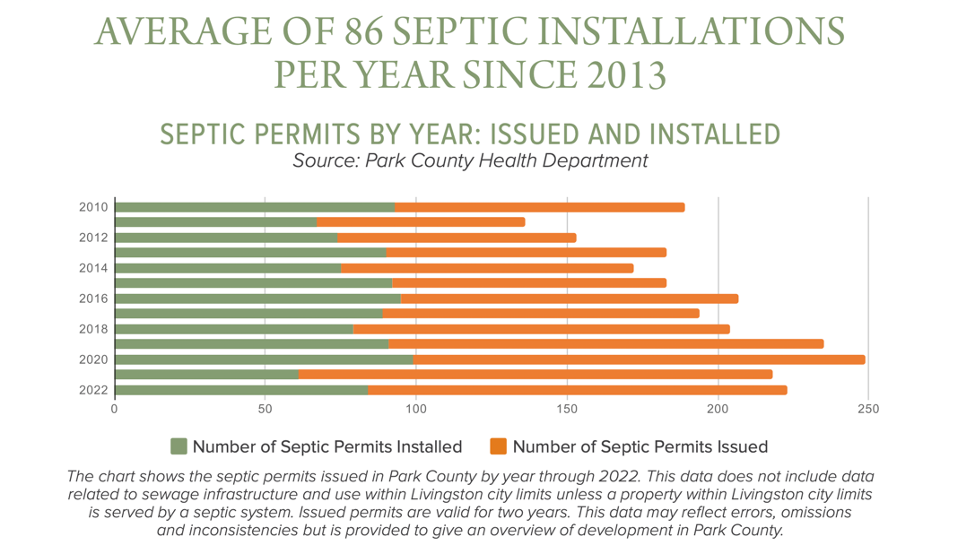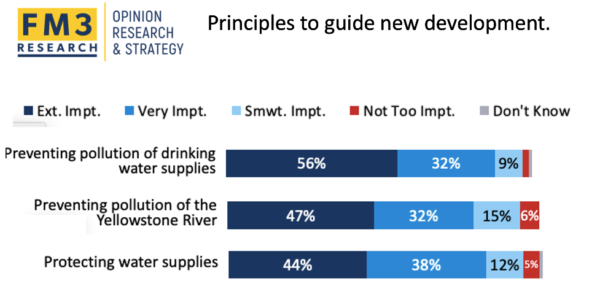Sewage Waste is a Terrible Thing Not to Mind
More than 40 million pounds of additional sewage waste will be going into the ground from septic permits issued each year in Park County
The Park County Community Foundation’s October 2023 state of the county report on issues and attitudes in Park County, We Will Park County, included this important table about septic permits:

What does this mean? It means almost 40 million pounds of additional sewage has been going into the ground each year in Park County, from sinks, showers and toilets each year on average. (Think that is an exaggeration? We share our calculations at the end of this story.)
As of the date of this article, the number of septic permits issued in Park County this year is 136 which would represent an annualized rate of about 150 new permits per year, so the number of installations is probably rising.
The standards for modern septic systems built starting in the 1990s are designed to protect our groundwater from bacteria contamination. Research shows they remove almost all bacterial contaminants, although other forms of pollution like nitrates remain after treatment.
But septic systems must be property sited, designed, constructed and maintained to be effective.
And there are many old systems approved decades ago, still being used, that don’t meet those standards.
Outbreaks of groundwater borne pathogens linked to septic systems have been documented in several locations in the Northwest. Over 400 people were infected with gastroenteritis related to contaminated groundwater in Flathead County, Montana, in 1995. . . .and a number of major outbreaks of gastroenteritis have been attributed to groundwater borne Norwalk-like virus in numerous states (Missoula Valley Water Quality District, 1996). Other pathogens of concern in wastewater effluent are protozoans like Cryptosporidium and Giardia. Improperly constructed drainfields, high water tables, or inappropriate geologic settings (fractured bedrock or karst systems) can allow pathogenic bacteria and viruses to reach groundwater, where they can survive for days and travel up to 30 meters.
Source: Septic System Impact on Surface Water, a publication of Tri-State Water Quality Council, June 2005.

Teton County Wyoming thought its septic systems would protect Fish Creek and other streams from contamination – but they were proven wrong. You can learn about what happened there in Friends of Park County’s short Pollution in Paradise video.
Without research on the effect of cumulative systems on the complex and not fully understood groundwater system and connections to our streams and rivers, how sure can we be that our streams and rivers will be protected from sewage contamination?
Some Montana counties do regular sampling of water quality from domestic wells, but not Park County, even though sample testing would not be very expensive. The Yellowstone River is not systematically tested for human bacterial contamination or other pollution from septic systems.
So we don’t even know what we don’t know.
What we can say for certain is that Park County voters feel strongly about protecting our water quality according to the scientific poll of voters commissioned by Friends of Park County, conducted last year:

Our poll found that 73% of Park County voters support banning new septic systems within 500 yards of the Yellowstone River and only 22% oppose that idea.
Take action
Let the County Commissioners know you want them to take action to safeguard our drinking water and fishing streams from pollution from human waste, starting with commissioning an independent scientific study of water quality risks from septic systems.
DISTRICT 1- MIKE STORY
Phone: c. 406-223-1548
DISTRICT 2- BRYAN WELLS
Phone: c. 406-223-9162
DISTRICT 3- CLINT TINSLEY
Phone: c. 406-224-3376 h. 406-222-0771
To contact the Commissioners collectively contact their Executive Assistant
Carly Ahern
406-222-4106
Our septic wastewater calculations:
Each person generates about 70 gallons of wastewater per day.
If each domestic septic permit serves an average sized household of 2.12 persons (that number comes from the US Census data for Park County) then 2.12 persons x 70 gallons/day x 365 days = 54,166 gallons.
Each gallon weights 8.34 pounds. So each septic system generates about 452,000 pounds of wastewater per year. 452,000 pounds x 86 new septic systems installed each year on average = 38.9 million pounds of additional wastewater going into the ground each year in Park County.
